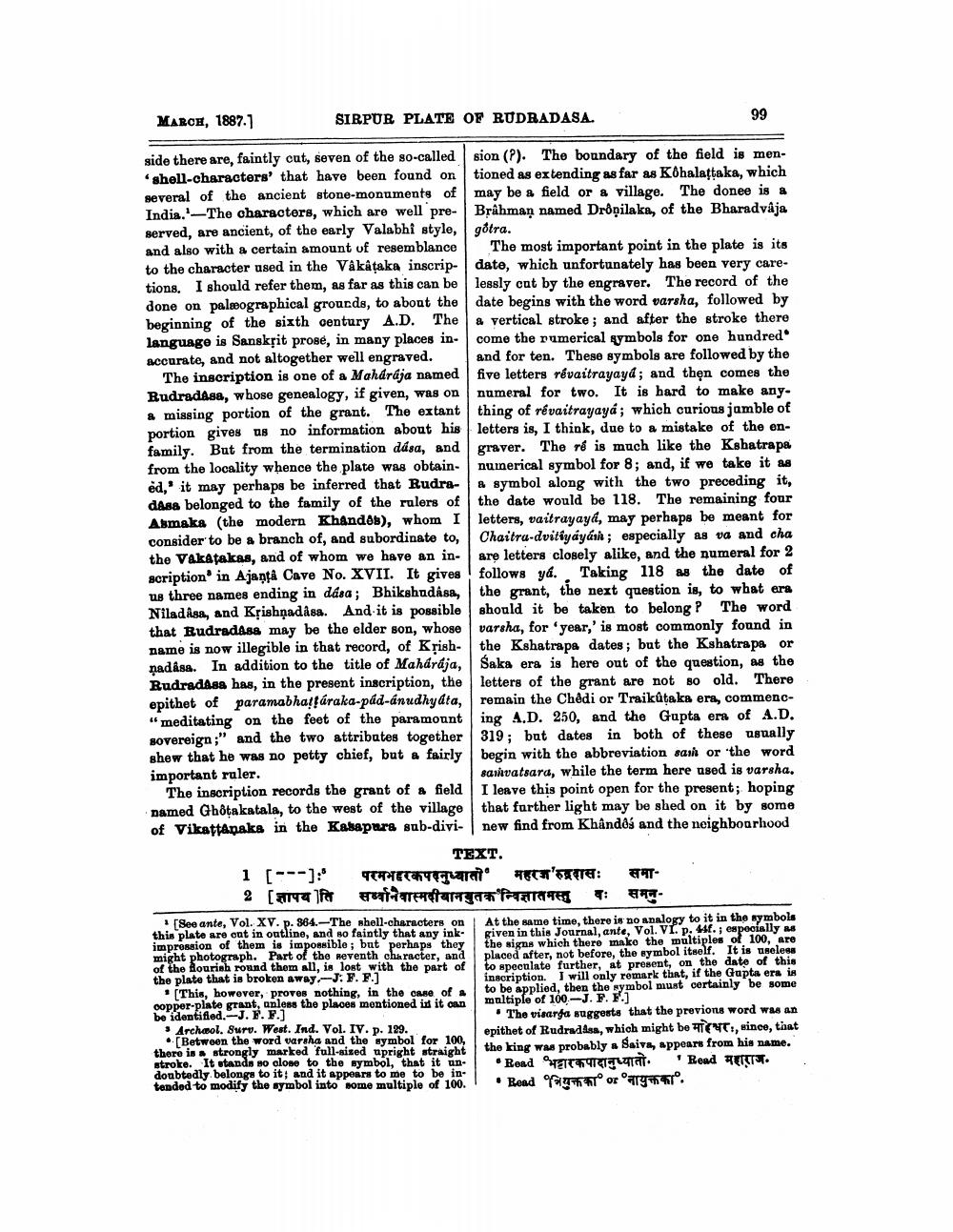________________
MARCE, 1887.1
SIRPUR PLATE OF RUDRADASA.
99
side there are, faintly cut, seven of the so-called sion (?). The boundary of the field is men
shell-characters' that have been found on tioned as extending as far as Khalattaka, which several of the ancient stone-monuments of may be a field or & village. The donee is a India. The characters, which are well pre-Brâhman named Drôņilaka, of the Bharadvaja served, are ancient, of the early Valabhi stylo, gôtra. and also with a certain amount of resemblance The most important point in the plate is its to the character used in the Vakataka inscrip- date, which unfortunately has been very caretions. I should refer them, as far as this can be lessly cut by the engraver. The record of the done on palmographical grourds, to about the date begins with the word varsha, followed by beginning of the sixth century A.D. The & vertical stroke ; and after the stroke there language is Sanskrit prose, in many places in. come the numerical symbols for one hundred accurate, and not altogether well engraved. and for ten. These symbols are followed by the
The inscription is one of a Maharaja named five letters rêvaitrayayd; and then comes the Rudradasa, whose genealogy, if given, was on numeral for two. It is hard to make any. a missing portion of the grant. The extant thing of rêvaitrayaya; which curious jamble of portion gives us no information about his letters is, I think, due to a mistake of the enfamily. But from the termination dása, and graver. The rê is much like the Kshatrapa from the locality whence the plate was obtain- numerical symbol for 8; and, if we take it as ed,' it may perhaps be inferred that Rudra- & symbol along with the two preceding it, dasa belonged to the family of the rulers of the date would be 118. The remaining four Asmaks (the modern Khandos), whom I letters, vaitrayayd, may perhaps be meant for consider to be a branch of, and subordinate to, Chaitra-dvitiyáyásh; especially as va and cha the Vakatakas, and of whom we have an in- are letters closely alike, and the numeral for 2 scription in Ajançà Cave No. XVII. It gives follows ya. Taking 118 as the date of us three names ending in dása; Bhikshudása, the grant, the next question is, to what era Nilad Asa, and Krishnadasa. And it is possible should it be taken to belong P The word that Rudradass may be the elder son, whose varsha, for 'year,' is most commonly found in name is now illegible in that record, of Krish- the Kshatrapa dates; but the Kshatrapa or nadása. In addition to the title of Mahárája, Saka era is here out of the question, as the BudradAss has, in the present inscription, the letters of the grant are not so old. There epithet of paramabhaltáraka-pád-dnudhydta, remain the Chêdi or Traikutaka era, commenc"meditating on the feet of the paramount ing A.D. 250, and the Gupta era of A.D. sovereign;" and the two attributes together 319; bat dates in both of these usually shew that he was no petty chief, but a fairly begin with the abbreviation sank or the word important ruler.
samvatsara, while the term here used is varsha. The inscription records the grant of a field I leave this point open for the present; hoping named Ghôtakatala, to the west of the village that further light may be shed on it by some of Vikattapaks in the Kakapara sub-divi- new find from Khandos and the neighbourhood
TEXT. 1 [---] परमभारकपदनुध्यातो' महरज'रुद्रदासः समा
2 [ज्ञापयति सानवास्मदीयानबुतकन्विज्ञातमस्तु वः समनु[See ante, Vol. XV. p. 864.-The shell-characters on At the same time, there is no analogy to it in the symbols this plate are ont in outline, and so faintly that any ink given in this Journal, ante, Vol. VI. p. 441.; especially as impression of them is impossible; but perhaps they the signs which there make the multiples of 100, are might photograph. Part of the seventh character, and placed after, not before, the symbol itself. It is useless of the fourinh round them all, is lost with the part of to speculate further, at present, on the date of this the plate that is broken away-J: F.F.)
inscription. I will only remark that, if the Gupta era in · [This, however, proves nothing, in the case of a
to be applied, then the symbol must certainly be some oopper-plate grant, anless the places mentioned in it can multiple of 100.-J. F. F.] be identified.-J. F. F.]
• The visarga suggests that the previons word was an Archeol. Suru. West. Ind. Vol. IV. p. 129. Between the word varsha and the symbol for 100,
epithet of Rudradasa, which might be TV, since, that there is strongly marked full-sized upright straight the king was probably a Sains, appears from his name. stroke. It stands no close to the symbol, that it un- • Read भट्टारकपादानुध्यातो. ' Read महाराज. doubtedly belongs to it, and it appears to me to be intended to modify the symbol into some multiple of 100. Read m orarytar.




